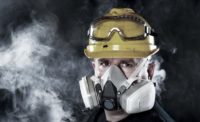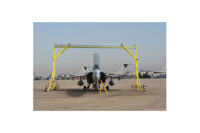Why has the number of injuries and deaths associated with falls from heights increased?
Several factors have contributed to these alarming and disturbing statistics:
• All fall protection equipment deteriorates with use and exposure over time, regardless of brand and/or manufacturer.
• Equipment is not inspected often enough for wear and damage.
• Proper training is not provided — often, the wrong equipment is selected for a particular situation, and equipment is not worn properly.
Those specifying or using fall protection equipment know these factors to be valid (at least at some subliminal level). Yet, it is very likely that a high percentage of equipment used on job sites throughout North America today would fail to meet safety standards if exposed to a fall.
On any given day, a visit to any job site in the country will unveil fall protection equipment being used that is potentially dangerous because of wear, neglect, misuse or age/exposure.
In one study, shock-absorbing lanyards from a variety of manufacturers were voluntarily removed from job sites for safety qualification, and 85% of the product samples failed standard safety tests (in accordance with ANSI Standards).
The test program focused on shock-absorbing lanyards from eight manufacturers and showed a variety of performance failures (lanyard test, 220 lbs. [100 kg] at 6 ft. [1.8 m] free fall):
• 100% did not pass visual inspection criteria [weld splatter, webbing cuts/abrasions, broken stitching, frayed/burned webbing, chemical damage, discoloration, deformed hardware (cracks/rough or sharp edges) and/or loose, distorted or broken grommets, etc.
• 6% had webbing that actually broke
• 24% elongated over the 42 inch (1.1 m) standard
• 83% had fall arrest forces over 900 lbs. (4 kN) (ANSI), with 9% over 1,800 lbs. (8 kN) (OSHA)
• 6% were previously deployed, but still in active service when removed from the job site
• 42% had hardware with visible defects
• 9% had snap hooks that opened during testing
• 9% had webbing that was knotted
The safety community must recognize these facts and take a proactive approach. Workers are being seriously injured in falls with equipment that initially passed industry safety standards. More troubling, worn and damaged equipment is still accessible even though it will not perform as designed in the event of a fall.
Safety directors and supervisors need to make a concerted effort to keep unsafe and potentially life-threatening equipment out of the hands of those working at heights. Workers, through proper training and attentive daily inspection, will be safer and injury free. Taking equipment out of service too early is a better alternative than explaining to a worker’s family that there has been a serious accident ... adopt a Smart Policy — when in doubt, throw it out!
What are key considerations to provide maximum fall protection safety?
Warnings – Always read all instructions and warnings contained on the product and packaging before using any fall protection equipment.
Inspection – All fall protection equipment must be inspected prior to each use.
Training – All workers should be trained by a Competent Person in the proper use of fall protection products.
Regulations – Understand all Federal, State, Local and Provincial regulations pertaining to fall protection before selecting and using the equipment.
Rescue planning – Minimizing the time between a fall occurrence and medical attention of the worker is vitally important. A thorough rescue program should be established prior to using fall protection equipment.
System components – Only components that are fully compatible with one another should be used. Fall arrest systems are designed and tested as complete systems and should be used in this way.
After a fall – After a fall occurs, all components of the fall arrest system should be removed from service.
Can I wash my harness/lanyard?
Basic care of all safety equipment will prolong the durable life of the unit and will contribute toward the performance of its vital safety function. Proper storage and maintenance after use are as important as cleansing the equipment of dirt, corrosives or contaminants. Storage areas should be clean, dry and free of exposure to fumes or corrosive elements.
Nylon or polyester: Remove all surface dirt with a sponge dampened in plain water. Squeeze the sponge dry. Dip the sponge in a mild solution of water and commercial soap or detergent. Work up a thick lather with a vigorous back and forth motion; then wipe with a clean cloth.
Drying: Hang freely to dry and dry thoroughly. Keep away from excessive heat and without close exposure to steam or long periods of sunlight.
What are the best practices for lanyard inspection?
Hardware
A) Snaps: Inspect closely for hook and eye distortions, cracks, corrosion or pitted surfaces. The keeper (latch) should seat into the nose without binding and should not be distorted or obstructed. The keeper spring should exert sufficient force to firmly close the keeper. Keeper locks must prevent the keeper from opening when the keeper closes.
B) Thimbles: The thimble must be firmly seated in the eye of the splice, and the splice should have no loose or cut strands. The edges of the thimble must be free of sharp edges, distortion or cracks.
Wire rope lanyard
Always wear gloves when inspecting a wire rope lanyard; broken strands can cause injury. While rotating the wire rope lanyard, watch for cuts, frayed areas or unusual wearing patterns on the wire. Broken strands will separate from the body of the lanyard.
Web lanyard
While bending webbing over a pipe or mandrel, observe each side of the webbed lanyard. This will reveal any cuts, snags or breaks. Swelling, discoloration, cracks and charring are obvious signs of chemical or heat damage. Observe closely for any breaks in stitching. Inspect lanyard warning flag for signs of activation.
Rope lanyard
Rotate the rope lanyard while inspecting from end-to-end for any fuzzy, worn, broken or cut fibers. Weakened areas from extreme loads will appear as a noticeable change in original diameter. The rope diameter should be uniform throughout, following a short break-in period.
Shock absorber pack
The outer portion of the pack should be examined for burn holes and tears. Stitching on areas where the pack is sewn to D-rings, belts or lanyards should be examined for loose strands, rips, deterioration or other signs of activation.
Shock-absorbing lanyard
Shock-absorbing lanyards should be examined as a web lanyard (as described above). However, also look for the warning flag or signs of deployment. If the flag has been activated, remove this shock-absorbing lanyard from service.
What are best practices for self-retracting lifeline inspection?
Check housing
Before every use, inspect the unit’s housing for loose fasteners and bent, cracked, distorted, worn, malfunctioning or damaged parts.
Lifeline
Test the lifeline retraction and tension by pulling out several feet of the lifeline and allow it to retract back into the unit. Always maintain a light tension on the lifeline as it retracts.
The lifeline should pull out freely and retract all the way back into the unit. Do not use the unit if the lifeline does not retract. The lifeline must be checked regularly for signs of damage. Inspect for cuts, burns, corrosion, kinks, frays or worn areas. Inspect any sewing (web lifelines) for loose, broken or damaged stitching.
Braking mechanism
The braking mechanism can be tested by grasping the lifeline above the load indicator and applying a sharp steady pull downward which will engage the brakes. There should be no slippage of the lifeline while the brakes are engaged. Once tension is released, the brakes will disengage and the unit will return to the retractable mode. Do not use the unit if the brakes do not engage.
Check the hardware. The snap hook load indicator is located in the swivel of the snap hook. The swivel eye will elongate and expose a red area when subjected to fall arresting forces. Do not use the unit if the load impact indicator has been activated.
Snap hook
Check the snap hook to be sure that it operates freely, locks, and the swivel operates smoothly. Inspect the snap hook for any signs of damage to the keepers and any bent, cracked or distorted components.
Anchorage connection
Make sure the carabiner is properly seated and in the locked position between the attachment swivel/point on the device and the anchor point.



